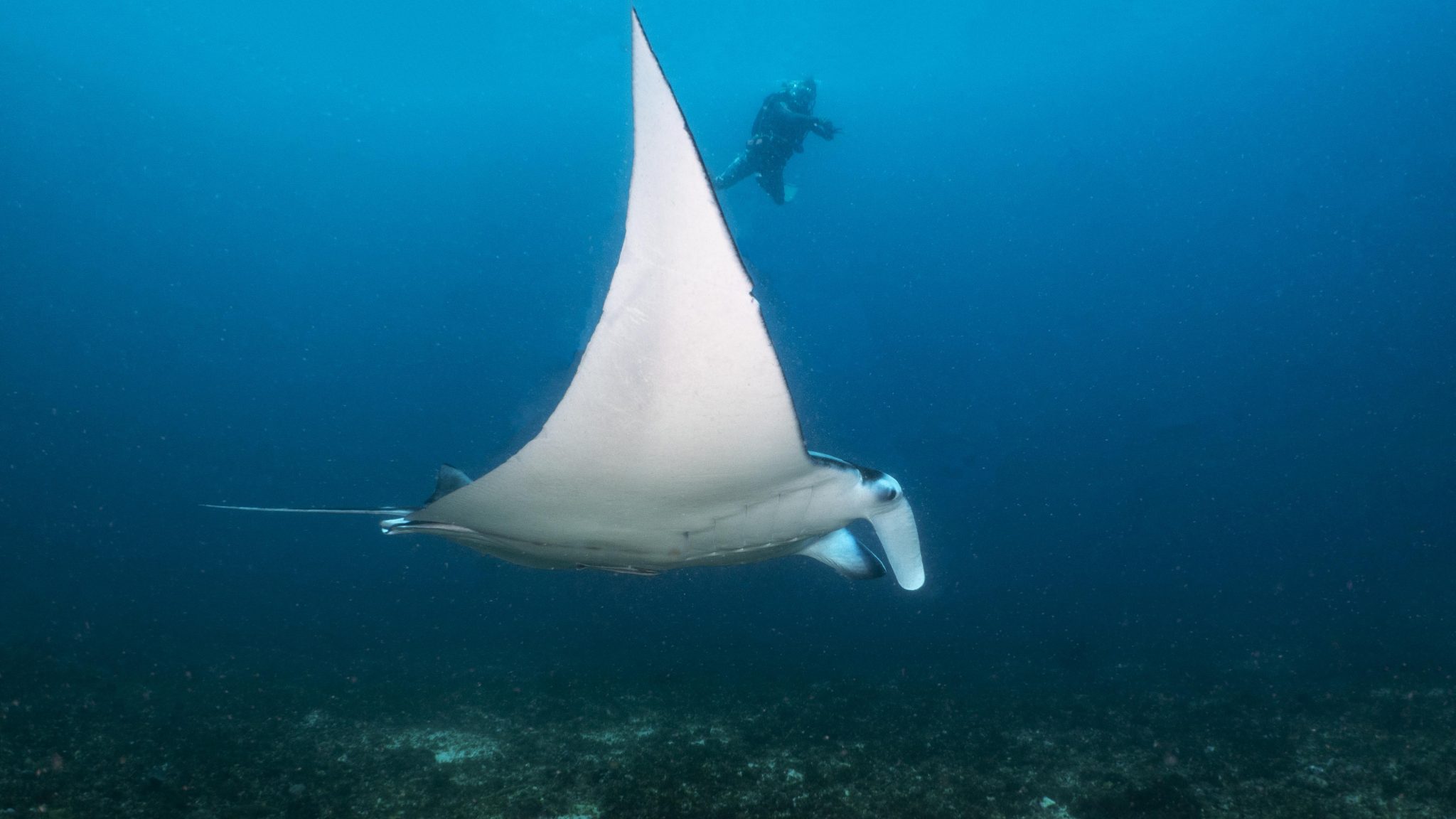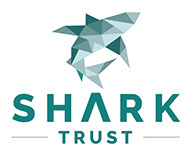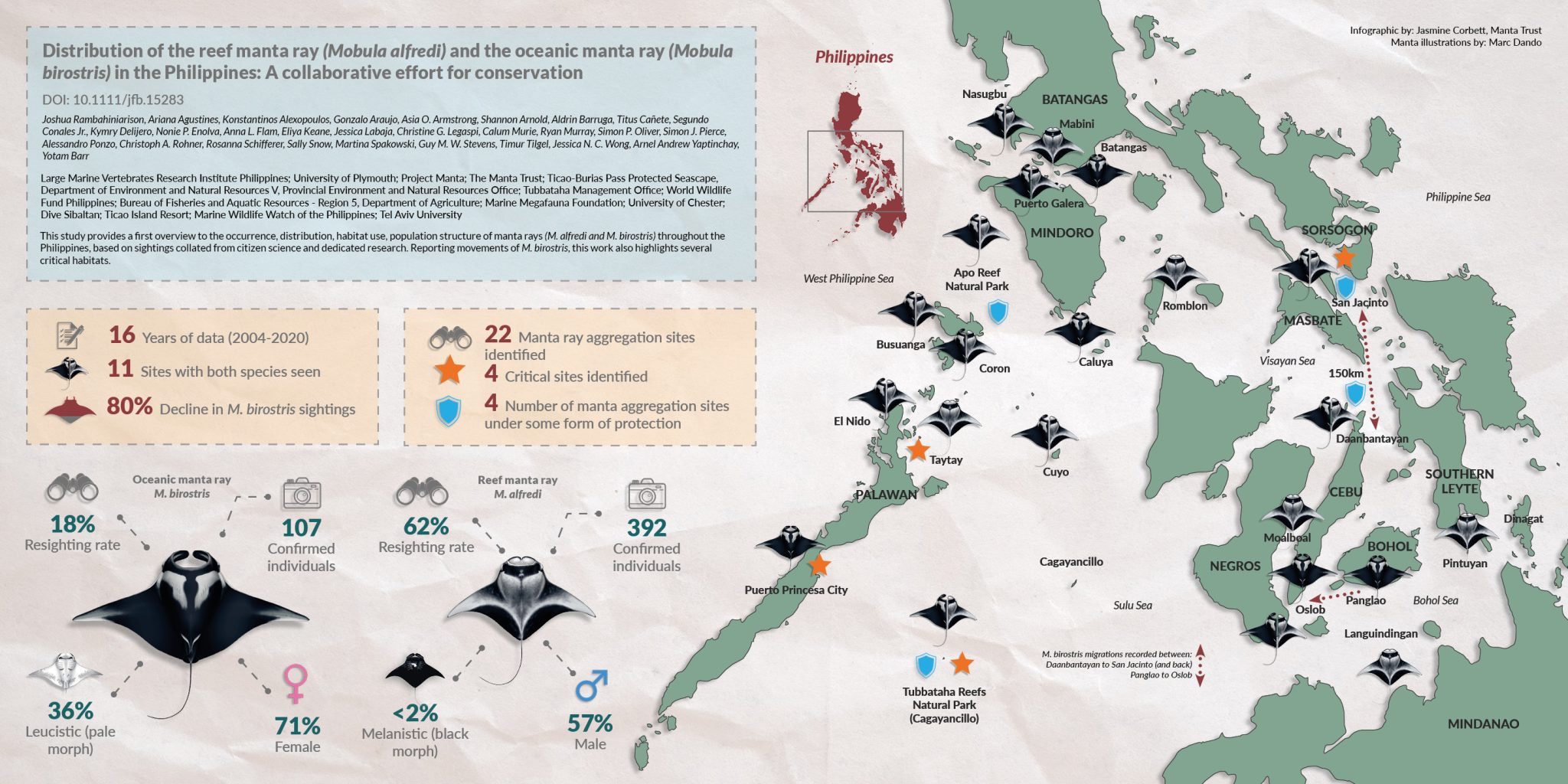Marine Life & Conservation
Collaborative research puts manta rays on the map in the Philippines

A new collaborative scientific study led by the Large Marine Vertebrates Research Institute Philippines (LAMAVE) and in cooperation with partners and the public has compiled a national population database for manta rays and has identified four hotspots for the species in the Philippines.
Sightings from dedicated in-water research efforts by LAMAVE and partners as well as citizen science contributions from dive centers, digital submissions on platforms like mantamatcher.org as well as online searches on social media platforms including Facebook, Instagram and YouTube have enabled the creation of the database. The study reports the presence of both Reef Mantas (Mobula alfredi) and Oceanic Mantas (Mobula birostris) in the country.
A total of 2,659 manta ray sightings were analysed by the team and from those, 499 individual manta rays were identified using photo-identification methods, which use the unique spot pattern on the ventral side (belly) of the manta ray. These individuals were encountered in 22 different sites across the Philippines, 11 of which both reef manta and oceanic mantas were observed.
Tubbataha Reefs Natural Park and Ticao-Burias Pass Protected Seascape identified as
hotspots Of these 22 sites, the study identified four hotspots where manta rays aggregate:
Tubbataha Reefs Natural Park in Cagayancillo, San Jacinto in the Ticao-Burias Pass Protected Seascape, Puerto Princesa City and TayTay in Palawan. Three of these hotspots are in the waters of Palawan. These four sites accounted for 89% of all the individual manta rays and specific behaviours were observed including cleaning, courtship and feeding.
In reference to the Tico-Burias Pass Protected Seascape Nonie P. Enolva, Senior Fishing Regulations Officer/Chief, Fisheries Resource Management Section, Bureau of Fisheries and Aquatic Resources – Region 5 had this to say – “Ticao Pass is one of the Bicol Region’s marine key biodiversity areas known to be home of filter-feeding megafauna like whale sharks, megamouth sharks and mobulas. The area has been known to be rich in plankton and other primary producers at the trophic level. The preponderance of visits of these megafaunas is greatly attributed to how rich the Ticao Pass is in terms of the primary food source that has been provided for them. Thus, the protection of this important fishing ground would also mean the protection of the many marine species that are dependent on it. The implementation of the Fisheries Management Area 7 which covers Ticao Pass would also warrant an Ecosystems Approach to Fisheries Management by providing policies that include protection of important marine species.”
Oceanic mantas keep coming back to the same areas Oceanic Mantas accounted for 107 individuals in the national catalog and resights of this species gave an insight into their movements. One female manta first sighted in Daanbantayan, Cebu in 2009, became the first recorded movement of an oceanic manta between sites in the Philippines when she was resighted in San Jacinto in 2014 and then back again in Daanbantayan in 2017. Another individual made a similar journey in 2017, covering ~150 km (straight-line movement) in five days.
Other records from Daanbantayan also revealed the longest resighting interval with two individual manta rays seen again in the area after an 8-year interval. Six other individuals were sighted in the area in at least two different years suggesting that the area is important for the species as they keep coming back. Ticao, Masbate and Palawan were identified as hotspots for reef mantas As for reef mantas, 392 individuals were identified from sighting records over 16 years between 2004-2020. Over 90% of these individuals were encountered in three sites: San Jacinto (Ticao-Burias Pass Protected Seascape), Taytay in Northern Palawan and Cagayancillo (Tubbataha Reefs Natural Park) in Palawan. In these areas 66-80% of the mantas identified were seen more than once, most often at cleaning stations – small patches of coral that house cleaning fish. The fact that two of these hotspots are within protected areas (Ticao-Burias Pass Protected Area and Tubbataha Reefs Natural Park) highlights the importance of these areas for the species and why the continued efforts to conserve them are crucial.
Both species are still under threat. The study highlights key threats continuing to face these species. A quarter of the animals identified in San Jacinto and Taytay showed fishery-related injuries, in the form of damaged or missing fins or severe cuts. Damage to cleaning stations is a further concern; the cleaning sites in San Jacinto are characterised by an abundance of fishing gear entangled in the reef resulting in damage or destruction of this sensitive habitat.
Meanwhile, sightings of oceanic manta rays (M. birostris) in Daanbantayan dropped from 73 sightings between 2006-2012 to only 16 sightings between 2013-2019 despite the increased diving effort in the area. San Jacinto showed a similar trend with 15 sightings between 2013-2014 to only three between 2017-2019. This is an alarming 80% decline in sighting frequency and may be attributed to fishing activities in part of its assumed population range, such as in the Bohol Sea which saw at least 100 oceanic mantas landed per season in the Bohol Sea up until 2017. The species has a population recovery time of over 37 years so protecting the remaining individuals is fundamental if we are to help the species recover.
Conservation strategies such as marine protected areas and fishing gear regulations should be urgently adopted at these sensitive sites, especially in the identified hotspots which do not currently benefit from species-specific protection such as Taytay and Puerto Princesa City.
For more information visit: www.lamave.org
Header Image: LAMAVE research, San Jacinto, Philippines. Credit: Olivia Johnson (LAMAVE)
Marine Life & Conservation
Shark Trust launches Oceanic 31 Shark Art Auction

 After a two-year tour of UK art galleries, community spaces and aquariums, the Shark Trust’s acclaimed Oceanic31 exhibition takes its final bow at the Royal Geographical Society later this month. And the unique collection of artwork, depicting 31 species of oceanic sharks and rays, donated by 31 artists, is now open for bids from art lovers and shark enthusiasts. The online auction, launched today, will close on the 7th December at 8pm (BST). The money raised will support the Shark Trust Oceanics Programme.
After a two-year tour of UK art galleries, community spaces and aquariums, the Shark Trust’s acclaimed Oceanic31 exhibition takes its final bow at the Royal Geographical Society later this month. And the unique collection of artwork, depicting 31 species of oceanic sharks and rays, donated by 31 artists, is now open for bids from art lovers and shark enthusiasts. The online auction, launched today, will close on the 7th December at 8pm (BST). The money raised will support the Shark Trust Oceanics Programme.
People can now bid on 27 of the artworks by visiting this website:
https://superstars-auctions.com/sharktrustauction
It is a chance to own a beautiful piece of original art and to support the Shark Trust. The timing of the auction also means that these would make a very special Christmas gift for any shark-lover.
- Bigeye Thresher Shark by Janina Rossiter
- Carcharodon carcharias by Jimmy Higgs
- Croc VR 2030 by Tom Mead
- Oceanic Whitetip by ATM
- Silky Street by ScapaJoe
The diversity of pieces mirrors that of the sharks and rays they represent. You can bid on paintings, digital creations, sculptures, mixed media and more. You can pick your favourite artist or species of shark. Or you can select the perfect artwork to make a statement in your home or office. Whichever you choose, you will be supporting the work to protect these amazing animals.
One of the pieces of art has been selected to be auctioned live by Steve Backshall at the For the Love of Sharks event at the Royal Geographical Society in London on the 29th November. In addition to this, two further pieces will be raffled at this event, giving people a chance to win an incredible piece of shark art. For the Love of Sharks is the Shark Trust’s flagship evening. A night to celebrate sharks. Steve Backshall is the headline speaker at this event that will see other prominent shark advocates join him on stage.
Tickets for the event can be snapped up here:
https://thesharktrust.org.uk/Event/flos24
Those that would like to see the Oceanic 31 exhibition have one final chance. It is being displayed at the Pavilion at the Royal Geographic Society from 26th November until the 7th December. Entry is free.
Find out more here:
https://www.rgs.org/events/upcoming-events/oceanic-31
Paul Cox, Shark Trust CEO, Said “This exhibition has given us the opportunity to reach out to a new audience. And inspire more people with the wonderful sharks and rays on which our Big Shark Pledge campaign is based. We are immensely grateful to the 31 artists who have worked so hard to create these works.”
Bid for your favourite Oceanic 31 artwork here:
https://superstars-auctions.com/sharktrustauction
Banner Image: Smooth Hammerhead by Alicia Hayden
Marine Life & Conservation
Meet Steve Backshall in the Bite-Back Prize Draw

Until 28 November, prizes worth a massive £10,000 – including experiences, products and tuition – feature in a line-up of items that can be won for £5 in an online prize draw to celebrate Bite-Back Shark & Marine Conservation’s 20th anniversary and help generate crucial funds for the future.
Top of the list of prizes is the chance to spend time with adventurer and wildlife expert Steve Backshall, a workout session with Nat Geo star Aldo Kane, a kayaking trip alongside white-water expert and diver Sal Montgomery and a Zoom call with ‘shark whisperer’ Cristina Zenato.
On top of that, some of the most admired companies in the diving and scuba industry have been quick to support the charity with fabulous prizes that make the £5 ticket price worth more than just a flutter.
Master Liveaboards, BSAC, Midlands Diving Chamber, Go Freediving and Blue Shark Snorkel have all generously donated experience prizes, while celebrated photographer Alex Mustard has donated a print and artists Scott Gleed and Olivier Leger have donated a sculpture and illustration to help boost the fundraising pot.
Fourth Element has donated Ocean Positive gear and LA watch company Nodus has gifted the charity a stunning dive watch. For land lovers, the charity has included a five star London hotel stay at Bankside Hotel plus a family visit to Longleat Safari Park in the roster of prizes.
Campaign director for Bite-Back, Graham Buckingham, said: “We’ve been overwhelmed with support from companies and individuals that we truly admire and who have supported us on our 20 year journey and we’re truly grateful to them all. While we feel incredibly proud of our achievements over the past two decades – and we are super excited about the next chapter – this prize draw isn’t a vanity project. It represents a real lifeline to our work and important advancements in the global protection of sharks. So we hope divers, dive clubs and even bargain hunters grab some tickets to make this a massive success.”
The charity hopes that the prize draw will generate crucial funds to launch a brand new, ground-breaking, campaign to enrol the public and increase support for the protection of sharks around the world.
To enter the competition visit www.bite-back.com/prizedraw. The prize winners will be announced on 1 December 2024.
-

 News1 month ago
News1 month agoIconic SS United States to become the World’s Largest Artificial Reef
-

 Blogs3 months ago
Blogs3 months agoNovoScuba’s Game-Changing Approach for Dive Store Owners: WE PAY YOU!
-

 News2 months ago
News2 months agoBook Review – 52 Assignments: Underwater Photography
-

 Gear News2 months ago
Gear News2 months agoDYNAMICNORD – New German diving brand enters the British market
-

 News2 months ago
News2 months agoExploring Cenote El Pit: A Diver’s Dream
-

 Gear News2 months ago
Gear News2 months agoTry BARE drysuits (and maybe even win one!) this Friday with Sea & Sea at North West Dive Fest
-

 News3 months ago
News3 months agoComing Soon – 52 Assignments
-

 News3 months ago
News3 months agoSave £200 per person per week at Pole Pole Lodge with Dive Worldwide






















